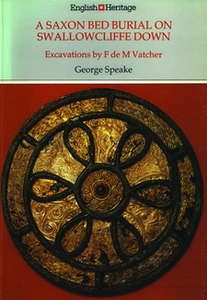English Heritage Archaeological Monographs
English Heritage, 2014. https://doi.org/10.5284/1028203. How to cite using this DOI
Data copyright © English Heritage unless otherwise stated
This work is licensed under the ADS Terms of Use and Access.
Primary contact
Historic England
The Engine House
Firefly Avenue
Swindon
SN2 2EH
Resource identifiers
- ADS Collection: 1416
- DOI:https://doi.org/10.5284/1028203
- How to cite using this DOI
A Saxon Bed Burial on Swallowcliffe Down: Excavations by F de M Vatcher
Speake, G.
English Heritage (1989)
Abstract:

Excavation of a Bronze Age barrow on Swallowcliffe Down, Wiltshire in 1996, revealed that it had been reused in the seventh century AD for a richly furnished Anglo-Saxon inhumation. The burial was that of a young female aged between 18 and 25, laid on an ash-wood bed with elaborate iron-work fittings, and surrounded by a collection of grave-goods of high quality. These included an iron-bound bucket and an iron pan at her head, a maple-wood casket containing a sprinkler and a spoon together with several other personal items laid at one side, and an orate satchel on the other. At the foot of the grave was a bronze mounted bucket. This full account of the grave, the circumstances of its discovery, and of its contents, describes these finds in detail and sets the material fully within its seventh-century context in art-historical terms. The significance of the bed burial is examined in the light of other examples of similar burial practices both locally and nationally. Examination of the documentary and topographical evidence for the Swallowcliffe barrow in the seventh century leads to the suggestion that it may be identified as Posses Hlaewe, recorded in a charter of AD940.
Download monograph
| A Saxon Bed Burial on Swallowcliffe Down: Excavations by F de M Vatcher, Speake, G., English Heritage (1989), ISBN: 9781848022133 | 34 Mb |





